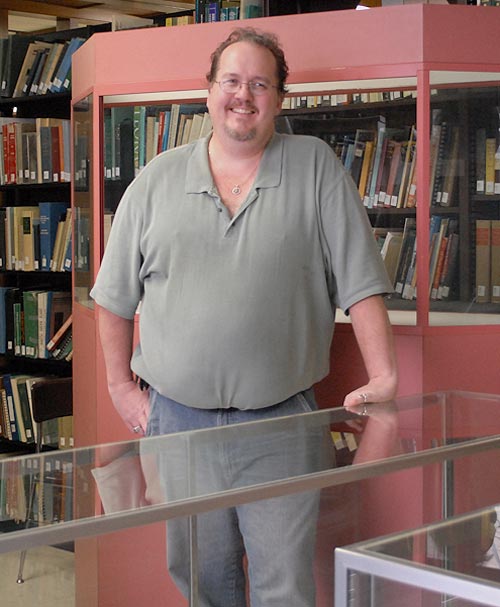Herbarium spruces up with new cases for 253,000 specimens
November 30th, 2010 Posted in Arts and LifeStory & Photo by Mark Vuong
LOGAN—With a $200 donation from the Gardner’s Market, the USU Herbarium met its quota to purchase glass display cases.
Michael Piep, the assistant curator at the herbarium, said the cases were a “screaming” deal. New ones, he said, go for about $1,500 each, but the herbarium bought five used ones for $425, and still has some money to paint the base of the cases—currently mauve—Aggie Blue.
“We’ve been looking for cases for probably five years,” Piep said.
The cases will be put in front of the herbarium, in the basement of The Junction, and will contain plant-based displays.
 Piep said the USU Herbarium was established in 1931 and serves as a kind of library for botanists—or anyone—to learn about plants and where they grow. Inside, the place is lined with rows of lockers housing more than 253,000 specimens. Each dried and pressed sample is identified by a slip of paper showing the collectors, date of collection, location, elevation and nearby plants.
Piep said the USU Herbarium was established in 1931 and serves as a kind of library for botanists—or anyone—to learn about plants and where they grow. Inside, the place is lined with rows of lockers housing more than 253,000 specimens. Each dried and pressed sample is identified by a slip of paper showing the collectors, date of collection, location, elevation and nearby plants.
Steve Ripple, a former president of the Cache Valley chapter of the Utah Native Plant Society, said data will be entered into a computer, allowing for a more extensive use of the plant details.
Despite the computer database, however, botanists continue drying and pressing the preserved specimens.
“You would think it’d become obsolete,” Piep said, “but in actuality a photo isn’t good enough to identify plants correctly. In the case of grasses or a daisy, you have to get in there and rip it apart and put it under a microscope. And it’s a little hard to do that with a photograph. Or if you want to go in and do some DNA analysis, you can’t do it with a photograph either.”
Piep said the USU Herbarium gathers data primarily within the Intermountain West, and other herbaria concentrate in their local regions. If an herbarium were to garner specimens from all over the world, he said the storage area would need to be as big as USU campus.
Herbaria work together to lend and exchange specimens and data. Piep said the USU Herbarium has sent specimens to Europe, Australia and Canada, and has received specimens from China, Europe, Australia and South America.
“Herbarium specimens are flying everywhere in the world, every day of the year,” Piep said, “going to and from researchers in herbaria for various studies and purposes.”
USU’s herbarium receives most of its funding from the College of Science, plus support from the Agricultural Experiment Station, research funding, from royalties of published books edited by the herbarium staff, and from contract work, such as identifying a plant for an independent botanist.
The herbarium works with the Utah Native Plant Society, whose members donated the initial $225 for the new display cases. The two groups often benefit from each other, Piep said, exchanging member contact information and specialized plant knowledge, Piep said.
The USU greenhouses also are used for the local chapter’s annual plant workshop, an instructional course on how to grow native plants from seeds and stems.
“Some other places just don’t have that relationship,” Ripple said. “How do you have a workshop about plants in somebody’s house or in a rented hall? It’s difficult.”
The USU Herbarium and the society’s local chapter host several events throughout the year, such as speakers, the Richard J. Shaw Wildflower Walk, plant workshops, mushroom hunting, among others. Anyone interested can visit the herbarium’s or the society’s website for more information.
TP
Tags: botanists, Herbarium, Michael Piep

2 Responses to “Herbarium spruces up with new cases for 253,000 specimens”
By Atlanta Lumber on Dec 1, 2010
Congratulations on achieving your quota to purchase the glass cases, this is really cool!
By Leila on Dec 5, 2010
Congratulations! Nice to get the news.